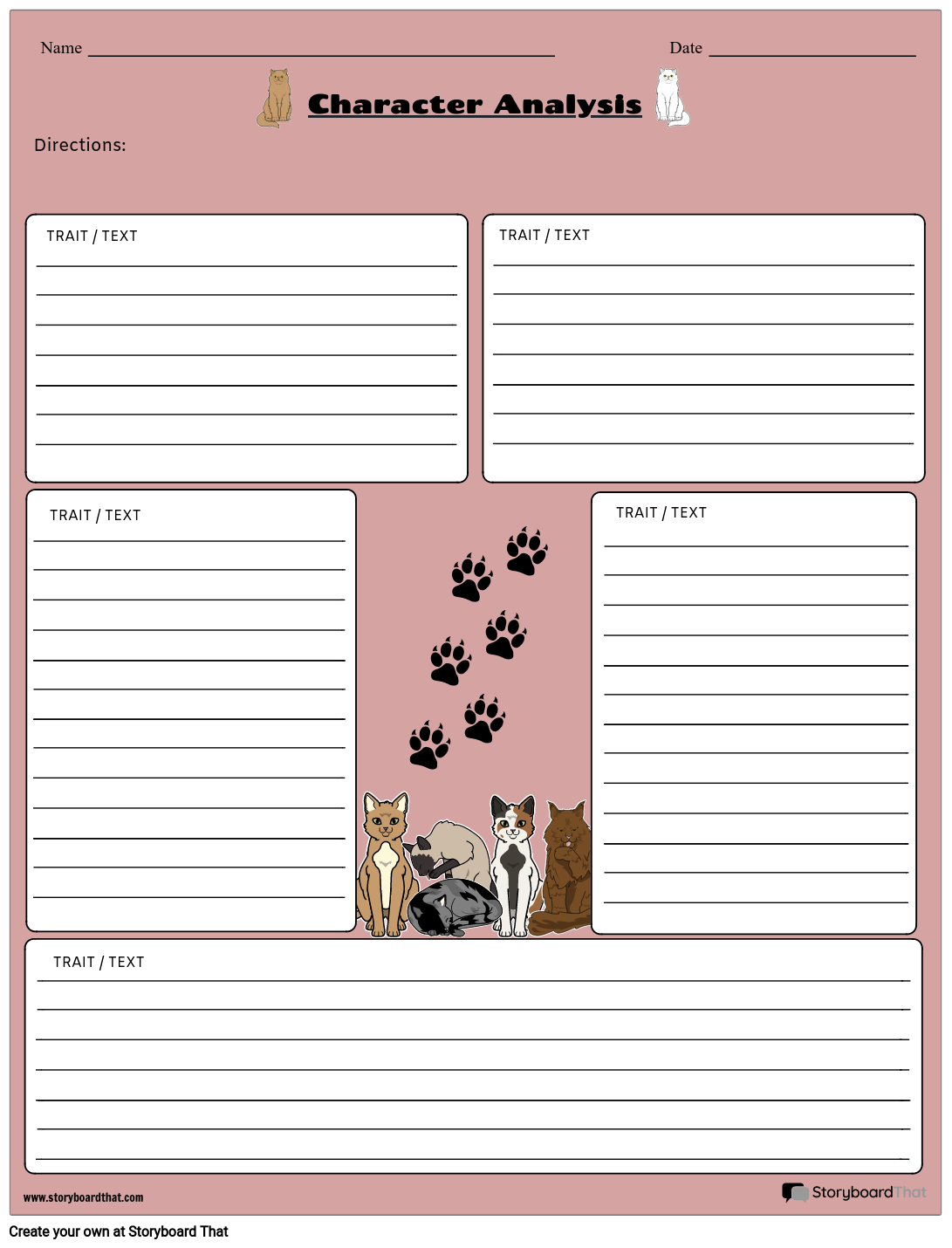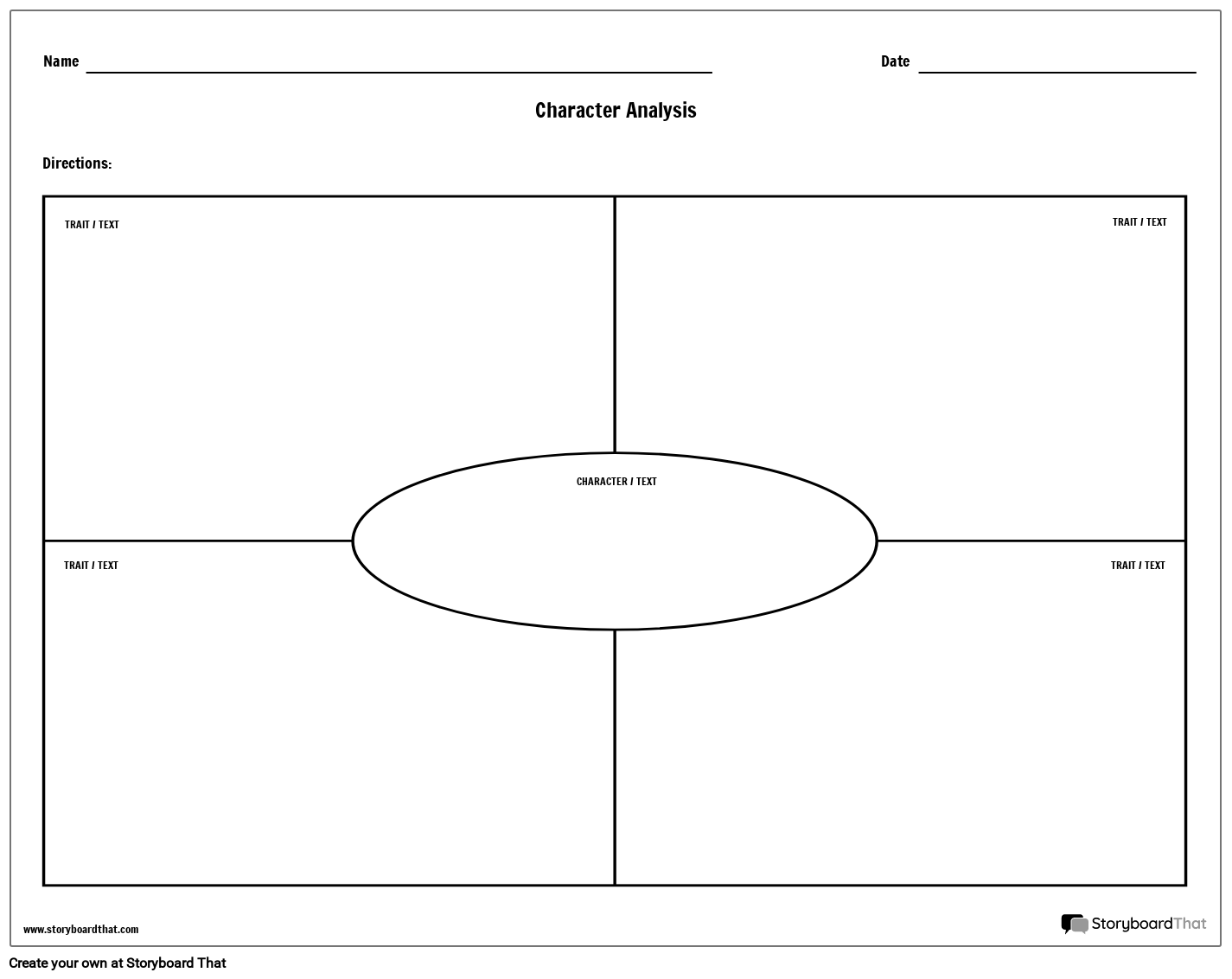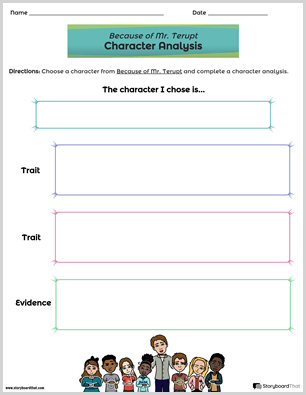Customize Character Analysis Templates
If you're assigning this to your students, copy the worksheet to your account and save. When creating an assignment, just select it as a template!
What is a Character Analysis Essay Worksheet?
A character study is an important aspect of literary analysis, and our character analysis worksheets provide a comprehensive framework for analyzing and understanding characters in a story. These templates allow students to create detailed profiles that explore various elements, such as development, traits, and interactions with other characters.
By using our character analysis chart templates, students can easily identify and describe the key traits. They can analyze the character's development throughout the story, examining how their experiences and choices shape their journey. Additionally, students can explore the relationships with other characters, uncovering the dynamics and impact of these interactions.
With our character development worksheet, a student can dive deeper into the life of a character, gaining a greater appreciation for their complexities and motivations. This in-depth exploration enhances their understanding of the story and encourages critical thinking skills.
How To Analyze Character Traits
Analyzing traits is a crucial aspect of understanding and interpreting literature. By examining the traits of a character, readers can gain deeper insights into their motivations, behaviors, and overall significance within a narrative. In this section, we will explore how to effectively analyze character traits using various strategies and tools, including character analysis worksheets and the concept of indirect characterization.
- Start with a Character Study Worksheet: Begin by utilizing a character worksheet, including character study worksheet, character analysis chart, or character profile worksheet, which serves as a structured framework to gather and organize information. This worksheet typically includes sections to record the character's physical attributes, personality traits, actions, relationships with other characters, and their overall role in the story. By filling out the worksheet, you can develop a comprehensive profile and identify key traits that shape their behavior.
- Identify Key Character Traits: As readers, pay close attention to the author's descriptions and the character's actions, dialogue, and how they interact with others. Look for recurring patterns or specific behaviors that reveal their personality. These can include traits such as kindness, courage, honesty, or cunningness.
- Consider Indirect Characterization: Indirect characterization refers to the author's use of subtle clues, such as a character's thoughts, speech, appearance, or the opinions of other characters, to reveal their traits. Analyzing indirect characterization requires reading between the lines and inferring the character's traits based on these subtle cues. Look for instances where the author indirectly explains or shows the character's traits, and use them to deepen your understanding of the character.
- Examine the Character's Actions and Choices: A character's actions and choices can provide significant insights into their traits. Consider how the character behaves in different situations and what motivates their actions. Reflect on whether their actions align with their stated beliefs or if they exhibit any contradictions. This analysis can help you identify the character's values, strengths, weaknesses, and overall character development and analysis throughout the narrative.
- Connect Traits to the Character's Role and the Narrative: Analyzing traits is not only about describing them but also understanding their significance in the context of the story. Consider how the character's traits contribute to their role within the narrative and their relationships with other characters. Reflect on how their traits impact the plot, conflict, and overall themes of the literature. This deeper understanding will enrich your analysis and interpretation.
By following these steps and utilizing a variety of our character analysis worksheets, you can effectively analyze character traits, explain their development, and gain a deeper appreciation for the complexities of the characters in literature. Remember to support your analysis with evidence from the text, such as specific quotes or examples, to provide a strong foundation for your insights and interpretations.
How To Write Character Analysis Essay
Now that you're armed with the knowledge and skills to analyze a trait, explore the world of literature with confidence and embark on your own captivating character analysis essays. When it comes to writing an analysis essay, having a well-structured outline is essential. The outline serves as a guide to help you organize your thoughts and ideas, ensuring that your essay effectively captures the complexities of the character and their traits. Let's explore how to create an outline using a character analysis outline worksheet, and how to incorporate the right words and language to showcase your analytical skills.
- Begin with a Character Profile: Before diving into the essay, it's helpful to create a profile that includes important details about the character's background, traits, and development. This profile can serve as a reference point and provide you with a clear understanding of the character's journey. You can refer to a profile example or use the character analysis outline worksheet to organize your thoughts.
- Introduction: Start your essay with an engaging introduction that provides a brief overview of the character and their significance within the narrative. Grab the reader's attention by highlighting the character's key traits or an intriguing aspect of their personality.
- Thesis Statement: Craft a strong thesis statement that presents your main argument or interpretation about the character. Your thesis statement should reflect the character's traits and their impact on the story, while also setting the tone for your essay.
- Body Paragraphs: Organize your analysis into coherent body paragraphs that focus on specific traits. Each paragraph should begin with a topic sentence that introduces the trait you will discuss. Use evidence from the text, such as quotes or specific examples, to support your analysis. Analyze how the character exhibits the trait and provide insights into their motivations, actions, and relationships with other characters. Be sure to incorporate the right words and language to showcase your analytical skills.
- Conclusion: Summarize your main points and restate your thesis in the conclusion. Emphasize the significance of the character's traits and their contribution to the overall narrative. You can also leave the reader with a thought-provoking question or a broader reflection on the character's impact.
By following these guidelines and incorporating the profile, a strong thesis statement, well-structured body paragraphs, and a concise conclusion, you can create a compelling character analysis essay that showcases your understanding of the character's traits and their significance in the story.
Example of Character Analysis Literature: Engaging Texts for In-Depth Study
Explore these recommended engaging texts that serve as excellent examples for an in-depth analysis. These literary works offer rich and complex characters that your class can delve into and analyze, allowing for a deeper understanding of character development, motivations, and relationships.
Pride and Prejudice by Jane Austen
This novel offers valuable lessons on social class, prejudice, and the complexities of human relationships, making it an ideal choice for teaching character analysis skills in the classroom. Use a character map to help kids analyze the traits and relationships of characters like Elizabeth Bennet and Mr. Darcy.
To Kill a Mockingbird
by Harper LeeThrough the characters of Scout, Atticus Finch, and Boo Radley, this novel will teach important themes of justice, morality, and empathy, providing ample opportunities to analyze their traits and motivations. Our digital worksheets can be used to engage students in interactive character analysis activities.
The Great Gatsby
by F. Scott FitzgeraldThe characters in this novel, such as Jay Gatsby, Daisy Buchanan, and Nick Carraway, exemplify the pursuit of the American Dream and the complexities of love and identity. Analyzing their traits can deepen students' understanding of human nature and societal expectations. A critical analysis template can help while examining the characters' motivations and the author's use of symbolism and imagery.
Jane Eyre by Charlotte Brontë
Jane Eyre's journey of self-discovery and her interactions with other characters, such as Mr. Rochester and Mrs. Reed, offer rich material for character analysis discussions. This novel explores themes of independence, morality, and the role of women in society.
Using these classic novels not only teaches students valuable skills in analysis but also exposes them to timeless themes, diverse perspectives, and literary techniques.
How to Make a Character Analysis Worksheet
Choose One of the Premade Templates
We have lots of templates to choose from. Take a look at our example for inspiration!
Click on "Copy Template"
Once you do this, you will be directed to the storyboard creator.
Give Your Worksheet a Name!
Be sure to call it something related to the topic so that you can easily find it in the future.
Edit Your Worksheet
This is where you will include directions, specific images, and make any aesthetic changes that you would like. The options are endless!
Click "Save and Exit"
When you are finished, click this button in the lower right hand corner to exit your storyboard.
Next Steps
From here you can print, download as a PDF, attach it to an assignment and use it digitally, and more!
Happy Creating!
Frequently Asked Questions About Character Analysis Worksheets
What is a character trait?
A character trait refers to the qualities, characteristics, or attributes that define a character in a literary work. These traits can include physical attributes, personality traits, values, beliefs, motivations, and more. Character traits help readers understand the motivations and actions of characters, and they play a crucial role in character analysis.
Can I create a character worksheet on my own?
Absolutely! Our worksheets provide a framework for analyzing characters, but you can also create your own customized character worksheets. You can tailor the questions and prompts to fit the specific needs of your students or the literary work you are studying. This flexibility allows you to focus on specific character traits or aspects that you want your students to explore.
How can character analysis worksheets help with writing a character analysis essay?
They serve as a valuable tool to gather and organize information about characters, which can then be used as evidence or supporting details in a character analysis essay. These worksheets help students identify and describe character traits, analyze character development, and explore the relationships between characters. By using the information from the worksheets, students can write a well-supported and insightful character analysis essay.
Can character analysis worksheets be used for different grade levels and texts?
Absolutely! They can be adapted for different grade levels and used with a wide range of literary works. Whether you are teaching elementary, middle school, or high school, you can modify the complexity and depth of the questions and prompts to suit the needs and abilities of all learners. Additionally, the they can be used with various texts, including novels, short stories, plays, and even films, allowing for versatility in the classroom.
© 2025 - Clever Prototypes, LLC - All rights reserved.
StoryboardThat is a trademark of Clever Prototypes, LLC, and Registered in U.S. Patent and Trademark Office













